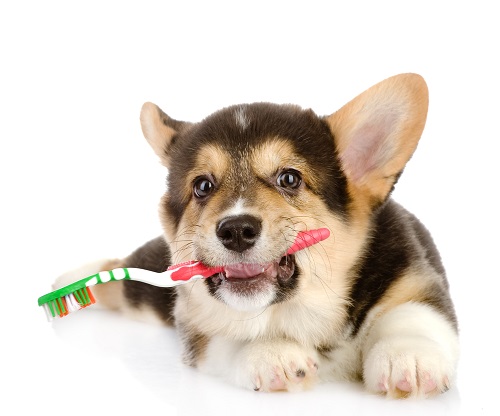 Routine dental care is essential to protect your pet’s oral health! We understand that it may seem difficult to keep your pet’s teeth clean, but it is important to get your pet used to the dental care that they need before they start showing signs of dental disease. Research shows that by the age of 2, 70% of cats and 80% of dogs have some sign of dental disease. If dental disease is left untreated, it could lead to severe pain, inflammation, tooth loss, and infections. There are a few things that you may notice if your pet is beginning to show signs of dental disease. It is important to look out for:
Routine dental care is essential to protect your pet’s oral health! We understand that it may seem difficult to keep your pet’s teeth clean, but it is important to get your pet used to the dental care that they need before they start showing signs of dental disease. Research shows that by the age of 2, 70% of cats and 80% of dogs have some sign of dental disease. If dental disease is left untreated, it could lead to severe pain, inflammation, tooth loss, and infections. There are a few things that you may notice if your pet is beginning to show signs of dental disease. It is important to look out for:
- Bad breath
- Sore mouth
- Difficulty eating or reluctance to eat
- Loose teeth, or tooth loss
- Pawing or rubbing the mouth
- Bleeding gums
- Yellow or brown calculus on the teeth
- Drooling
Below are a few tips to help protect your pet’s oral health
Tooth Brushing
Brushing your pet’s teeth is the single most effective means of removing plaque from the visible surface of the tooth. First, select a pet toothbrush based on the size of your pet. It is important to positively enforce the desired behavior of allowing their mouth to be handled. By carefully lifting the lips, calmly talk to your pet while touching their lips and teeth. Follow that action with a reward, praise, or their favorite treat. By offering the treat, it is rewarding your pet for holding still. We prefer owners to start this routine once or twice daily with a reward. Our goal is to foster a cooperative spirit within a week and then move onto organized brushing with a soft-bristled toothbrush.
Introduce this daily brushing to your pet by gently lifting the upper lip one side at a time. Using your index finger, touch the large canine tooth, and slowly move toward the back of the mouth to the large upper cheek tooth (4th premolar). Please do not use human toothpaste because it contains fluoride, which should not be swallowed. We recommend brushing the outside of the teeth only, with the soft bristles should be directed at the gum line in a back and forth motion. Plaque and tartar tend to accumulate in different areas for different pets. The key is to utilize the abrasive action of the toothbrush. Try to brush daily or at least three times per week!
Dietary Texture
Special dietary texture also serves to reduce plaque quite well. Only the oversized and highly abrasive kibble of Hills Science Diet T/D has the clinical studies proving that it will reduce the accumulation of plaque and calculus. Although not as effective as brushing, T/D does offer those unwilling patients the excellent option of prevention.
OraVet
OraVet significantly reduces plaque and tartar formation by creating an invisible barrier that helps prevent bacteria from attaching to your pet’s teeth. This breakthrough approach to oral healthcare begins in the clinic when your veterinarian applies the OraVet Barrier Sealant after your pet’s dental cleaning. The application continues at home in conjunction with tooth brushing when you apply the OraVet weekly to your pet’s teeth and gum line. This system helps reduce plaque and calculus formation on your pet’s teeth between dental cleanings. Similarly to tooth brushing, this product only needs to be applied to the outside of your pet’s teeth.
Other Options
Other options that can help reduce your pet’s risk of dental disease include exercise toys, rawhides, and other dental treats (such as CET treats) that can help reduce plaque to a minor degree. These items massage the gum tissue and should be used only as a supplement to tooth brushing or T/D diet. Cow hooves, nylabones, real bones, and hard plastic toys should be avoided.
Professional Dental Cleanings
Professional cleaning and polishing restores your pet’s oral health and provides a healthy environment for you to keep clean. Even with good home care, most pets will require professional teeth cleaning at regular intervals. Each pet and certain breeds have their owner susceptibility to plaque and tartar accumulation and periodontal disease.
Professional Dental Cleanings
10 Steps to a Complete Oral Health Exam and Treatment (COHAT)
- Pre-operative Lab Work and Physical Exam – Lab tests help us determine if there are any problems with your pet’s body organs, which allow us to customize the safest anesthesia protocol for your pet. A pre-op physical exam ensures your pet’s safety while under anesthesia.
- Full Mouth Dental Radiographs – The full mouth x-rays allow us to see the internal structure of each tooth under the gum line. Without dental radiographs, 60-70% of injuries, diseases, and infections of the mouth will be missed and left untreated, which makes the radiographs a critical part of the COHAT.
- Dental Exam – All teeth are probed and examined by the doctor performing your pet’s dental procedure. All of your pet’s teeth are charted and examined for any missing or injured teeth. The surrounding tissues of the teeth are also examined for any abnormalities. Owners go home with a chart of their pet’s teeth, showing which, if any, teeth were missing prior to the dental, and which teeth were removed.
- Supragingival Scaling – This is the ultrasonic scaling of the crowns of your pet’s teeth. Though there may be residual staining, all of the tartar and calculus is removed from the tooth surfaces.
- Subgingival Scaling – The surfaces of the tooth under the gum line are also scaled to remove any calculus build-up that would otherwise cause continued dental disease.
- Polish – All visible surfaces of the teeth are polished after they are scaled so that the teeth are more resistant to new plaque accumulation.
- Fluoride Treatment – Fluoride helps decrease tooth sensitivity, strengthens enamel, and decreases the rate of future plaque formation.
- Dental Sealer – Our clients have 2 options for dental sealers. Oravet is a product that we apply to the teeth during the procedure to help seal the tooth-gum barrier and needs to be reapplied by the owner once weekly. The second option is Sanos, which seals the tooth-gum barrier for 6 months after it is first applied, and is recommended for owners who are unable to treat their pet’s teeth at home.
- Home Care – After a dental procedure it is important to make daily tooth brushing a part of you and your pet’s daily routine. If your pet will not allow you to brush his or her teeth, ask our technicians for alternatives that will help your pet avoid dental disease.
- Follow-up Appointment – If any teeth were extracted, we ask that your pet is brought in 2 weeks postoperatively to make sure the areas are healing well. We also request to see your pet 3 months after a dental procedure to make sure that all of the areas have healed well and to check in on your pet’s overall dental health.
If you are concerned that your pet is exhibiting any signs or symptoms of dental disease, please schedule an appointment with your veterinarian immediately. The information provided here is for educational purposes only. Any treatment plan for your pet should be made on an individual basis between you and your veterinarian.








